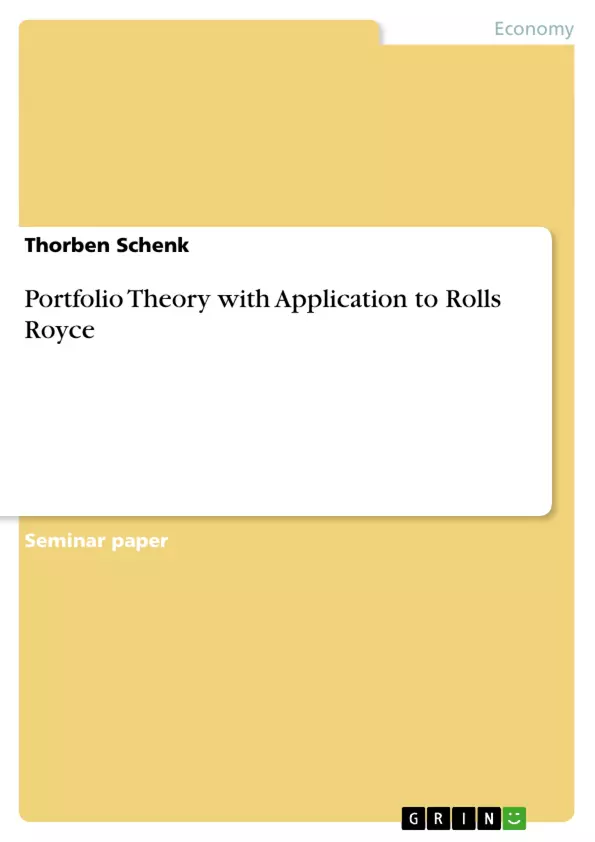Introduction
“Modern portfolio theory is the philosophical opposite of traditional stock picking.1“ It provides a tool with which it is possible to reduce the risks in business and private investments. At the same time it is the basis for the Capital Asset Pricing Model (CAPM).
This short assey introduces both the theoretical framework of Modern Portfolio Theory (MPT) and the CAPM which are then applied to Rolls-Royce plc. As this is just an overview the reader must be aware that this outline doesn´t go too deep.
Inhaltsverzeichnis (Table of Contents)
- Introduction
- Portfolio Theory
- Capital Asset Pricing Model
- The Company - Rolls-Royce plc.
- Rolls-Royce Business Segments
- Civil Aerospace
- Defence Aerospace
- Marine
- Energy
- Corporate Objectives
- Rolls-Royce Business Segments
- The Application to Rolls-Rolls plc.
- Financial Information
- Diversification
- Capital Asset Pricing Model
- Critique
- Conclusion
- References
Zielsetzung und Themenschwerpunkte (Objectives and Key Themes)
This essay provides an overview of Modern Portfolio Theory (MPT) and the Capital Asset Pricing Model (CAPM), applying them to Rolls-Royce plc. It aims to illustrate how these models can be used to reduce risk in business and private investments. The essay discusses the benefits of diversification and explores how investors can optimize expected returns for a given level of market risk. It also examines the relationship between risk and return, highlighting the importance of the Beta Factor.
- Portfolio theory and risk reduction
- Diversification and its benefits
- Capital Asset Pricing Model (CAPM)
- Risk-return relationship and Beta Factor
- Application of MPT and CAPM to Rolls-Royce plc.
Zusammenfassung der Kapitel (Chapter Summaries)
- Introduction: Introduces the concepts of Modern Portfolio Theory (MPT) and the Capital Asset Pricing Model (CAPM) and their significance in managing investment risk. The essay also highlights the importance of diversification.
- Portfolio Theory: Explains the theory, introduced by Harry Markowitz, which explores how risk-averse investors construct portfolios to optimize returns for a given level of risk. It discusses the benefits of diversification and the concept of an efficient frontier of optimal portfolios.
- Capital Asset Pricing Model: Describes the CAPM, which differentiates between unsystematic (specific) and systematic (market) risk. It introduces the Beta Factor, a measure of a security's sensitivity to market variations. The essay explains how the CAPM is used to calculate the cost of capital for companies and as a risk indicator for investors.
- The Company - Rolls-Royce plc.: This section provides an overview of Rolls-Royce's business segments, including Civil Aerospace, Defence Aerospace, Marine, and Energy. It also outlines the company's corporate objectives.
- The Application to Rolls-Rolls plc.: This chapter explores how MPT and CAPM can be applied to Rolls-Royce. It focuses on the company's financial information, diversification strategies, and the calculation of the cost of capital using the CAPM.
Schlüsselwörter (Keywords)
This essay focuses on Modern Portfolio Theory (MPT), Capital Asset Pricing Model (CAPM), diversification, risk management, risk-return relationship, Beta Factor, and application to Rolls-Royce plc. These keywords represent the core concepts explored in the work, highlighting the intersection of financial theory and real-world business application.
- Quote paper
- Thorben Schenk (Author), 2004, Portfolio Theory with Application to Rolls Royce, Munich, GRIN Verlag, https://www.grin.com/document/28471



